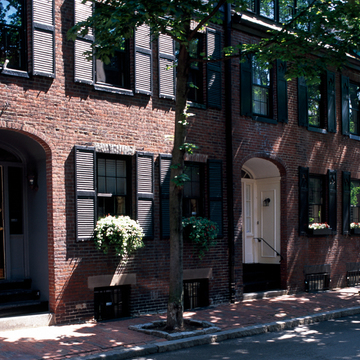In Boston it is safe to assume that any flat terrain represents filled land, and the tiny enclave south of Park Square known as Bay Village is no exception. Following the construction of a tidal dam in 1825, brick row houses, modest in size but charming in detail, began to rise on the former mudflats of the South Cove. Some early houses were occupied by housewrights working on nearby Beacon Hill. The very earliest, such as those at 42–52 Fayette Street, are notable for their elliptically arched entrance recesses and splayed window lintels, typical of the Federal style. Later houses, such as 33–37 Melrose Street, feature the square-headed openings and heavy entablatures of the Greek Revival. The
In the first half of the twentieth century, commercial and light industrial uses became prevalent within the neighborhood, adding a number of handsome warehouse and factory buildings to the local building stock. Some were exotically Moderne in style, as at 95–97 Broadway and 105–115 Broadway. The proximity of Bay Village to the Theater District made it particularly attractive to the entertainment industry. Several Hollywood studios, including MGM, United Artists, and Columbia Pictures (45 Church Street), built film distribution facilities in the neighborhood, some of which remained active until quite recently. Designated as a local historic district in 1984, Bay Village has experienced many of the same development pressures that have transformed other downtown Boston neighborhoods, as rooming houses, nightclubs, and commercial and industrial enterprises have yielded to a seemingly unquenchable demand for luxury housing. Ironically, after many decades of mixed use, the neighborhood is perhaps more exclusively residential today than it was in the nineteenth century.





















